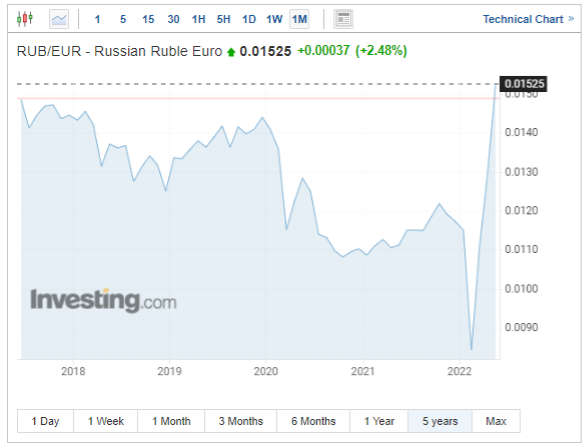Rast cen je hiter
Za primerjavo: marca je bila medletna rast cen v Rusiji 16,69-odstotna. Če pogledamo mesečno rast cen življenjskih potrebščin, lahko ugotovimo, da je bila rast cen najvišja od januarja 1999, ko je marca 2022 dosegla 7,61 odstotka. Nato se je aprila močno upočasnila na 1,56 odstotka.
Krepi za zajezitev inflacijskih pritiskov
Letna stopnja inflacije je precej nad ciljno vrednostjo ruske centralne banke, ki je določena pri 4 odstotkih. Kmalu po ruski invaziji na Ukrajino je lokalna centralna banka več kot podvojila ključno obrestno mero z začetnih 9,5 odstotka na 20 odstotkov, da bi zajezila inflacijske pritiske in podprla tečaj rublja. Ruska valuta je marca padla na najnižjo raven doslej, potem ko so zahodne države obsodile vdor vojske v Ukrajino in proti Rusiji uvedle vrsto sankcij. Banka zdaj napoveduje, da bi lahko inflacija še letos dosegla raven med 18 in 23 odstotki. Da bi podprla gospodarstvo, je znižala tudi osnovno obrestno mero z omenjenih 20 odstotkov na 14 odstotkov.
Ruba si je po padcu hitro opomogla
Vrednost ruske valute si je kljub občutnemu padcu kmalu po začetku vojne v Ukrajini razmeroma hitro opomogla od zgodovinsko najnižjih vrednosti, ki jih je dosegla v prvih dneh po začetku vojaške kampanje. Po podatkih Evropske centralne banke je vrednost rublja 1. marca 2022 znašala 117,2 rublja za evro, kar je skoraj 67 odstotkov manj kot v prejšnjem obdobju.* Vendar je vrednost rublja v primerjavi z evrom v petek prejšnjega tedna zaradi več dejavnikov dosegla petletno najvišjo vrednost. Potrošniki so začeli kupovati več osnovnih živil in drugega blaga v strahu, da se bodo cene še močneje zvišale. Da ne omenjamo, da povpraševanje po ameriških dolarjih in evrih upada zaradi omejitev čezmejnih transakcij in upada uvoza iz Rusije. Tečaj rublja podpira tudi dejstvo, da morajo izvozna podjetja svoj zaslužek prodajati v tej valuti.
Zahodne države so upale, da bodo uvedene sankcije proti Rusiji in s tem povezana oslabitev ruske valute Putinu preprečili financiranje vojne. Vlagateljem ne preostane drugega, kot da počakajo na razvoj razmer.

Razvoj vrednosti valutnega para RUB/EUR v zadnjih 5 letih (graf: Investing.com)
* Pretekli rezultati niso zagotovilo za prihodnje rezultate.
Olivia Lacenova, analitik pri licencirani družbi Wonderinterest Trading Ltd.